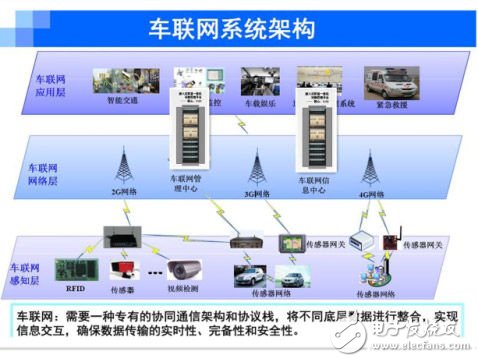According to the definition of the China Internet of Things School-Enterprise Alliance, the Internet of Vehicles is a huge interactive network composed of information such as vehicle location, speed and route. Through GPS, RFID, sensors, camera image processing and other devices, vehicles can complete the collection of their own environmental and status information; through Internet technology, all vehicles can transfer their various information to the central processor; through computer technology, these Information on a large number of vehicles can be analyzed and processed to calculate the best route for vehicles, report road conditions in a timely manner, and arrange signal light cycles. The Internet of Vehicles is a segmented application of the Internet of Things in the automotive field. It is the only way for the mobile Internet and the Internet of Things to develop into business and depth. It is also a fusion technology for the future development of information communication, environmental protection, energy saving, and security. Internet of Vehicles uses radio frequency identification technology to digitally manage vehicles, including real-time tracking and monitoring of vehicle operating conditions. Like the Internet of Things, the foundation of the Internet of Vehicles is the sensor. It is indispensable to strengthen the operation of the sensor. It combines information such as traffic signals, cameras, traffic jam reports, and weather conditions to form an "interconnection" between cars and roads. Through the communication and cooperation of the roads and technical management departments, the organic combination of cars, roads and people is realized, and the network of vehicles is truly formed. The Internet of Vehicles system refers to the use of advanced sensor technology, network technology, computing technology, control technology, and intelligent technology to comprehensively perceive roads and traffic to realize the interaction of large-scale and large-capacity data between multiple systems. Cars control the whole process of traffic, and carry out full-time and space-time control of each road to provide networks and applications that focus on traffic efficiency and traffic safety. One basic technology in the Internet of Vehicles is the video capture and storage (perception layer) of the camera. There are many car DVR and car IP Camera. Car DVR, commonly known as MDVR or car recorder. It is based on digital video compression storage and 3G wireless transmission technology (DigitalVideoRecord), combined with GPS positioning monitoring, car driving recorder, SD card mass storage, multi-channel data interface, voice call function. From the beginning, it only supports local recording to the current real-time transmission through 3G wireless, built-in GPS, car black box, CANbus bus, G-SENSOR and other technical applications. The market potential of car DVR is increasing. The four-channel video capture solution developed by Shanghai Chenhan Electronics based on the i.MX27 multimedia application development platform was widely used in the field of vehicle video transmission. According to the new definition of the Internet of Vehicles, in response to customer customization of products and differentiated market segments, this set of schemes has burst out new vitality, with small development volume, stable and mature, flexible cutting, and accelerated mass production progress. Customers make the best choice for system development and selection in the field of car video transmission. The chip's built-in H.264 hardware codec and eMMA ensure fast and smooth video recording and playback; FEC (Fast Ethernet) ensures smooth and unimpeded transmission processing. The chip can also reach the car's temperature level, which can truly meet the use in harsh environments. These cannot be handled by other chips of ARM9 level. In addition, this four-channel video solution supports a lot of peripheral interfaces: multiple UART interfaces, Wi-Fi & BlueTooth interface, GPS interface, USB interface, TV in (TV decode), TV out (TV encode), other interfaces : Hitachi 1.8 "micro hard disk standard interface (ATA), SD / MMC card interface, 2 million pixel CMOS Sensor interface.
Gaming Headphones is a headset suitable for playing games. For game users, a game headset with excellent performance can allow players to experience the immersive feeling in the game. For competitive game players, the game headset can also assist game players and enhance combat effectiveness.
Gaming Headphones,Gaming Headset,Rgb Gaming Headphones,Gaming Bluetooth Earphones Henan Yijiao Trading Co., Ltd , https://www.yjusbcable.com
Figure car networking system architecture
In the case of headphone use, we found that game use would be a large part of the demand, especially the need to use a pure headset to get better listening effect when both music and games are in use.
Compared with music headphones, Wired Game Headphones pay more attention to sound field and positioning sense (for example, shooting and shootout games need positioning), and the amount and intensity of low frequency are aggravated, so as to meet the user's experience of game sound effects. Music headphones, in essence, pay more attention to sound quality. The effect in the right range is super good, with pure sound quality and penetrating sound.
Among the many headsets, Wireless Gaming Headphone have the advantage of sensitivity. The relatively closed listening environment is also more conducive to game players to feel the details of the sound and improve their judgment of the sound. Therefore, compared with traditional headsets, gaming headsets have more advantages in positioning ability, can better express the sense of direction of sound, and are more suitable for 3D games to express sound clearly. In addition, player-oriented game headsets are often enhanced with low-frequency volume sensing to facilitate the game's plot and make it easier for players to immerse themselves in the game.
